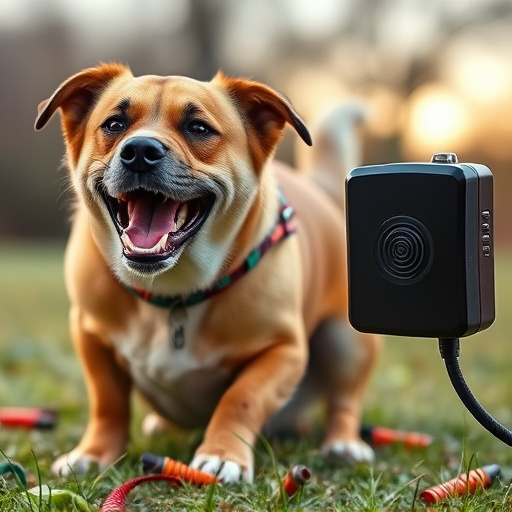Excessive dog barking disrupts neighborhoods, prompting the search for effective solutions like anti-barking devices (dog repellers). These technological approaches deter dogs through sound waves, ultrasonic tones, or spray dispensers without harming them. Choosing energy-efficient models is crucial, especially in areas with limited electricity access, to ensure long-term use and minimize environmental impact. A comprehensive review of dog repeller device power consumption, focusing on brands prioritizing energy efficiency, helps consumers make informed decisions tailored to their needs, contributing to a peaceful neighborhood environment.
Tired of noisy neighbors and barking dogs? Discover effective solutions with anti-barking devices, designed to mitigate neighborhood disturbances. This comprehensive guide explores dog barking patterns and their impact on communities, introducing advanced repeller technologies and their working mechanisms. We dive into an extensive review comparing top brands, focusing on power consumption for eco-conscious consumers. Learn how these devices can create a peaceful environment without sacrificing comfort or safety.
- Understanding Dog Barking Patterns and Their Impact on Neighborhoods
- Introduction to Anti-Barking Devices: How They Work
- Evaluating Power Consumption of Top-Rated Dog Repeller Devices
- Comprehensive Review: Comparing Efficiency and Effectiveness of Popular Dog Repeller Brands
Understanding Dog Barking Patterns and Their Impact on Neighborhoods
Dog barking is a natural behavior, but excessive or unwanted barking can disrupt neighborhoods and cause conflicts among residents. Understanding barking patterns is key to addressing this issue effectively. Dogs bark for various reasons, including territorial defense, attention-seeking, fear, anxiety, or boredom. Identifying triggers specific to each dog in a neighborhood can help tailor solutions. For instance, a device that detects high-frequency barks indicative of anxiety may use ultrasonic tones to soothe the animal without disturbing neighbors.
Evaluating anti-barking devices’ power consumption is an essential consideration for long-term use. Some products rely on constant power, which can be a concern in areas with limited access to electricity or where frequent battery changes are inconvenient. A thorough review of energy efficiency and runtime, such as those offered by top-rated dog repeller devices, ensures the technology remains effective without becoming a hassle. This aspect is crucial for maintaining a peaceful neighborhood environment consistently.
Introduction to Anti-Barking Devices: How They Work
Anti-barking devices have emerged as a solution to manage and control excessive dog barking in neighborhoods. These innovative tools are designed to deter barking without causing harm or distress to the animals, making them popular among homeowners seeking peaceful environments. Dog repeller devices operate on various principles, primarily focusing on sound waves, ultrasonic tones, or spray dispensers to discourage unwanted barking.
The technology behind these devices varies, but they generally work by detecting a dog’s bark and then emitting an unpleasant sound or scent that disrupts the animal’s behavior. Some models use motion sensors to activate only when a dog approaches, reducing unnecessary power consumption. Power efficiency is a significant consideration for many users, as reviewed products often highlight low energy usage, ensuring these devices can operate reliably over extended periods without frequent battery replacements.
Evaluating Power Consumption of Top-Rated Dog Repeller Devices
When evaluating dog repeller devices, understanding their power consumption is a significant aspect to consider, especially if you’re looking for a long-lasting solution for your neighborhood peace. Top-rated dog repeller devices often boast advanced features like motion sensors and ultrasonic technology, which can impact their energy usage. A thorough review of these products should assess how much electricity they consume in different operating modes.
Some devices claim to be energy-efficient, utilizing solar power or rechargeable batteries. This not only reduces environmental impact but also ensures cost savings for users over time. Contrarily, battery-powered options might require frequent replacements, leading to increased operational costs. Therefore, a Dog Repeller Device Power Consumption Review should analyze and compare these factors to help consumers make informed decisions based on their specific needs and preferences.
Comprehensive Review: Comparing Efficiency and Effectiveness of Popular Dog Repeller Brands
When considering an anti-barking device, a comprehensive review of popular dog repeller brands is essential to understanding their efficiency and effectiveness. These reviews delve into the core functionalities, technology employed, and most importantly, the power consumption of each device. In today’s digital era, consumers seek solutions that are both effective in addressing barking issues while also energy-efficient to minimize environmental impact and operational costs.
Popular dog repeller brands vary significantly in their approach, from ultrasonic devices that emit high-frequency sounds to spray-based repellents. A thorough review should assess these methods based on their ability to deter dogs without causing harm or distress. Additionally, examining power consumption is crucial, as it directly impacts the device’s longevity and operational costs. Brands that prioritize energy efficiency not only contribute to sustainability but also offer a more cost-effective solution for long-term use in neighborhoods with persistent barking issues.
In addressing the issue of dog barking in neighborhoods, anti-barking devices offer a humane and effective solution. By understanding dog behavior and evaluating the power consumption of various repeller devices, we can make informed decisions to create peaceful living spaces for everyone. The comprehensive review highlights the efficiency and effectiveness of top brands, providing a clear path towards selecting the ideal dog repeller for specific needs. Through responsible use, these tools can foster harmonious coexistence between pet owners and their neighbors.
